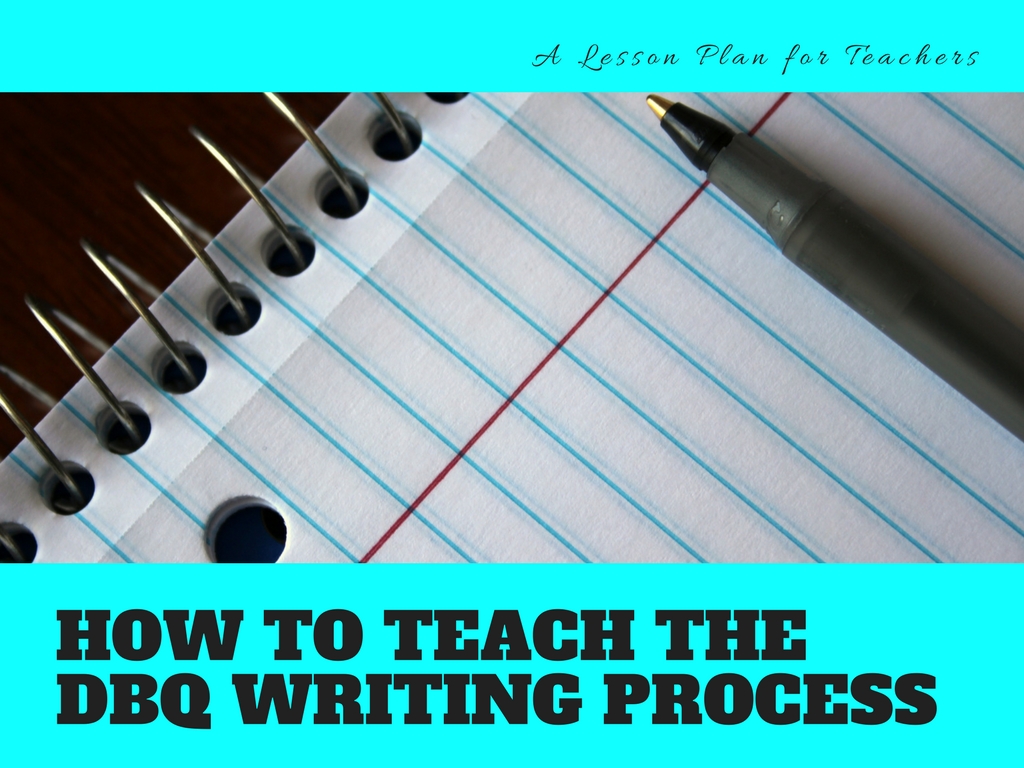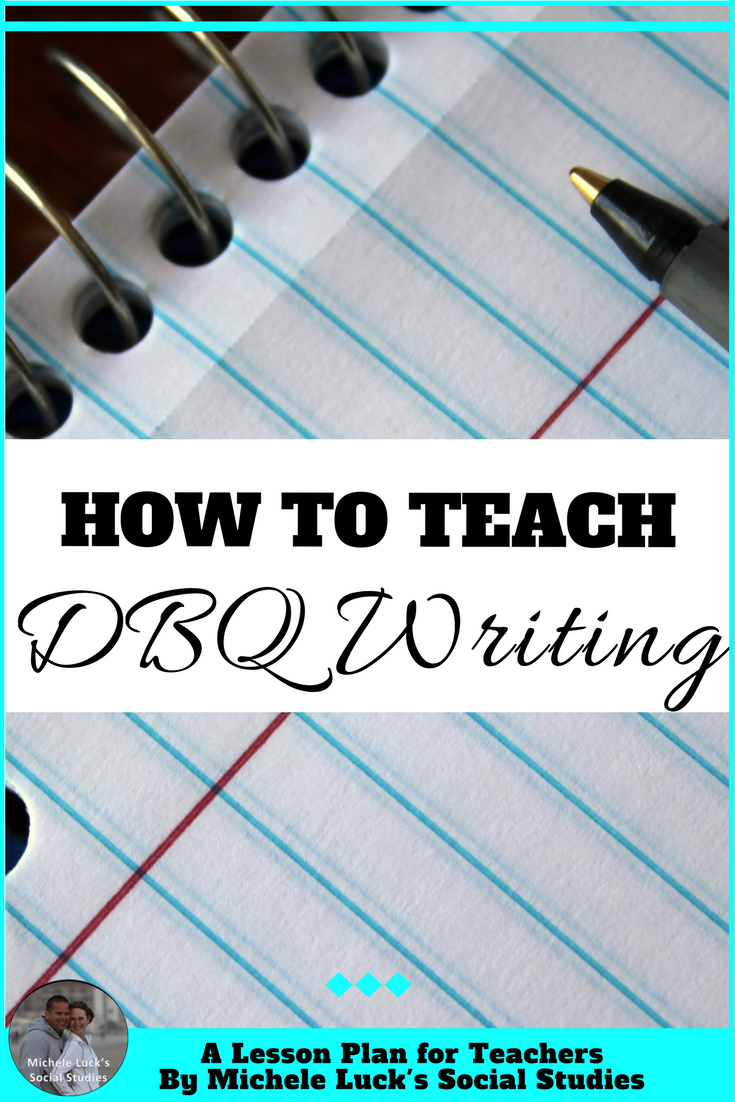Teaching the DBQ Process can be as overwhelming for teachers as it is for students. Facing the challenge with a set step-by-step guide can help to overcome the obstacles for introducing this task in any grade level. Having a plan can also reduce the stress felt by you and your students, and can help lead you and your students to DBQ writing success!

FIRST: Reminders for Teaching DBQ Writing
- Teach the steps independently. Do not try to teach the entire process in a day, week, or even month. It is a process and should be built up as the school year progresses.
- Allow students the time, resources, and encouragement to master each step before you move on to the next. If students are stuck on primary source analysis, they will never be able to move on to inference or corroboration.
- Be confident for your students and help them build confidence in themselves. Do not tell your students you are working on the DBQ Process or even on a writing process. Too many students are easily spooked by these types of writing, and will turn off before you can introduce the lesson. Instead, teach the independent steps, and then tell them they have mastered the DBQ!
- Plan time for practice. Primary source analysis, categorization, corroboration, and all of the other skills required for DBQ writing should not be isolated for a writing task. Analyze primary sources as bellringers. Categorize with a simple acronym every time you read text or examine a source. Practice the steps in everything you do. Then putting them together will be a breeze!
- Teach students to be observant. Observation is the key skill in DBQ writing. And even better, observation is an incredible skill in navigating life! If they can master it for your writing task, they can master it for anything.
Steps for Teaching the DBQ Writing Process
Again, remember that these are steps you will do one at a time with practice built in for mastery of each before moving on to the actual writing of the DBQ. Do them one at a time, or each in different activities you do within your class lessons, but do not introduce them all together for the purpose of DBQ writing. It would overwhelm any student and turn many off to the lesson altogether.
1. Teach Analysis
Teach the basic skill of analysis. Do this in every lesson you teach. Whether students are reading from a text or using a map for a Geography lesson, they are analyzing the information found within the document. Explain this to students and help them follow key steps for thorough analysis.
-
- Encourage students to value what they see. This first step is vital for students to get to the overall significance of any document or source.
- Ask students to record the basics. This is analysis, but you do not need to disclose that it is analysis until it is mastered. Build confidence in your students by celebrating the little victories as they complete each step.
- What is in the document?
- Who is involved?
- Who created the document?
- What biases may they have had?
- Did they have a purpose in creating the document or in participating in the event?
- When did it happen?
- What historical setting may have played a role in the document creation?
- Where did the event occur?
- Is the location important?
- Where was the document created?
- Does the creation location play a role in creating bias?
- Why did the event take place?
- Why was the document created?
- What is the significance of the event and the document?
- What is the big picture?
- Practice. Practice. Practice. Practice analysis orally. Practice with documents. Practice with maps and images and charts and graphs. Analyze advertisements, brochures, videos, news articles, notes you catch them passing in class. Analyze everything! Read more on analysis strategies here!
2. Teach Categorization
Teach the skill of categorization. Do this in every lesson you teach. Make it simple and make it memorable. Provide students guides for categorization or use acronyms to help with recall and processing. And teach it as a skill we do in everyday life.
- Start with a simple guide. I used SPRITE since it was also utilized by the College Board for AP testing. Get students accustomed to the guide and help them to learn the individual categories.
- S – Social
- P – Political
- R – Religious
- I – Intellectual
- T – Technological
- E – Economic
- Practice grouping items in a variety of ways. Use comparison diagrams to help students see the individual categories AND how they correlate with other categories. Create color codes for class specific categories and be methodical in your delivery and practice of these categories.
- Practice. Practice. Practice. Like with analysis, categorization is a step that should be done with every source utilized in the classroom. Make it a habit for all students, and when it is needed for assessment, they will practice it will ease.
3. Teach Historical Thinking
Teach Historical Thinking for every topic introduced in your Social Studies classroom. For younger students, make it simple by asking how the topic is important in time. Why does it matter now? For older students, push further to help them make connection to the cycle of historic events and peoples. Help them evaluate trends over time and change as a result of those trends. Using historical thinking will help to guide them to a better understanding of then and now.
- Teach students to recall what they already know on the topic. Encourage them to examine what they learned in the previous lesson or last unit.
- Help students visualize history as a timeline. Create a classroom timeline as you move from unit to unit to help students create this visual representation of history.
- Teach students to ask the question: How does that time and place in history impact this topic? If they can make those connections, they are thinking historically!
- In DBQ writing, this historical thinking will be the flow of their piece. The background information, the theme, the era in history… will set the premise for writing the response.
4. Teach Opinion Versus Position
Many students are quick to give opinions about topics in history, but they are unsure how to develop a position. And there is a difference. You must remind them that a position is supported by their historical thinking. If it doesn’t pass the time test, it is not an appropriate response position.
- Start with right versus wrong. Most students can understand this comparison quite quickly. Be sure to stress the historical thinking again, and reiterate that what is right now may not have been then!
- Practice writing opinion pieces. Use these as your daily bellringers or for exit writing. There is nothing wrong with writing opinions. However, there is an appropriate time and place for them, and in DBQ Writing, they must know the difference.
- Practice writing position statements. I assigned position statement writing on the very first day of school in my AP classes. We discussed a simple, familiar topic, examined current events or other sources to beef up the discussion, and then students had to write a clear position statement in the last five minutes of class. And time is important. This position statement will eventually form their complete thesis statement, and being able to come up with a thesis statement quickly will help them to jump through the rest of the hoops toward task completion easier with less stress.
5. Teach Thesis Statement Writing
I taught thesis writing in collaboration with my ELA teachers. There are many strategies for teaching this skill, but in choosing your strategy, be sure to consider your students and the age appropriateness for each strategy.
- Follow a simple checklist for thesis statement writing.
- Write a clear position.
- Include your categories for follow-up and further discussion in your paragraphs.
- Check for historical accuracy.
- Evaluate the statement for optional conclusions.
- Make sure it is clear and concise.
- Teach students to double check that their documents and the categories they created will fit their thesis statement.
- Reiterate the importance of being concise in the thesis writing process. They are not using the documents in their thesis, but will introduce them appropriately in the final steps.
6. Teach the DBQ Writing Process
This is just the burger of the meal! Once students are confident in the creation steps of the DBQ Writing Process, they can easily put it all together as they write their final piece.
- Historical setting or context introduction
- Thesis Statement with category inclusion
- Body paragraphs with individual thesis statements for each category following the same introduction from the overall thesis statement
- Inclusion of documents into each paragraph based on appropriate fit with category, including appropriate citations and comparisons with other documents
- Addition of other relevant knowledge, including primary sources that are missing from the provided DBQ set.
- Check that bias and point of view from document analysis has been included in paragraphs
- Write a clear and concise conclusion that wraps up the thesis statement and a potential call to action or declaration of potential resolution appropriate for the historical period.
 DBQ Writing should not be as scary as many students (and teachers) make it out to be. It is simply the compilation of steps and skills we are already teaching in the Social Studies classroom. Make it fun. Make it an everyday occurrence. Make it doable. If you take it step-by-step, your students will build the confidence they need and will be DBQ masters before you know it!
DBQ Writing should not be as scary as many students (and teachers) make it out to be. It is simply the compilation of steps and skills we are already teaching in the Social Studies classroom. Make it fun. Make it an everyday occurrence. Make it doable. If you take it step-by-step, your students will build the confidence they need and will be DBQ masters before you know it!
Need Ready-to use resources that practice these skills? Find them here!
And find no-prep DBQ and other writing resources here!
Happy Teaching!
